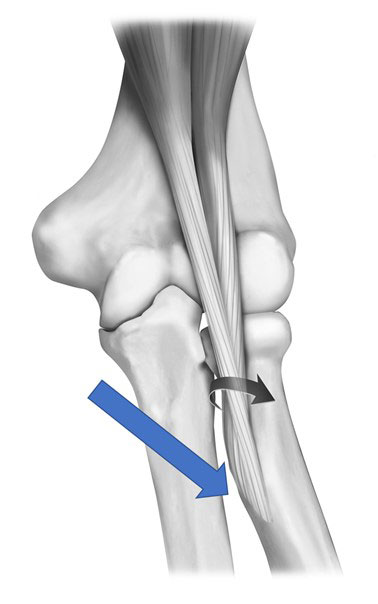Bicep Tendon Tear Overview
The bicep muscle plays a crucial role in the ability to help lift, rotate, and move your upper arm. The muscle is located in the front of the upper arm (humerus) and has two muscle bellies (long and short) that each attach to the shoulder blade separately. Additionally, the biceps muscle attaches to the forearm bone (radius) near the elbow. A bicep tendon tear can occur at any of the sites where the tendon attaches the muscle to bone; however, tears in the tendon of the short head of the biceps are extremely rare. Tendon tears generally occur through falls, sports related injuries or chronic wear and tear. Patients may experience pain, loss of strength, and limited movement in either the shoulder or elbow. Patient’s may also have a difficult time turning the forearm over (pronation-supination), depending on the location of the tear.
There are a couple varieties of a biceps tendon tears:
- A partial bicep tear is one that does not completely sever the tendon
- A complete bicep tear —also referred to as a biceps tendon rupture—will fully split the tendon or completely tear it away from bone
Anatomy
The biceps muscle is located in the front of the upper arm bone (humerus) and has two muscle bellies (long and short) that each attaches to the shoulder blade separately. Additionally, the biceps muscle attaches to the forearm bone (radius) near the elbow.
Most bicep ruptures are the result of on-going, continuous strain and wear and tear on the biceps muscle. This is most commonly seen in weight and strength training patients and usually starts with fraying of the tendon. As the injury to the tendon progresses, it will eventually tear. These bicep tears can occur in two distinct ways:
- At the shoulder joint: A proximal biceps tendon rupture is an injury to the biceps tendon at the shoulder joint. This is the most common bicep tendon tear and typically occurs in patients 60 years of age or older. This injury creates minimal symptoms and usually will heal on its own.
- At the elbow joint: A distal biceps tendon rupture is an injury at the elbow joint and are relatively uncommon. It most commonly affects middle-aged men and is caused by heavy lifting or sports. Most people who suffer from this injury will need to have surgery in order to correct the problem.
Symptoms of a Biceps Rupture
Symptoms associated with a bicep rupture include sudden, sharp upper arm pain—sometimes with a noticeable snap or popping sound. Cramping, bruising, swelling, pain, and tenderness of the shoulder, biceps and elbow are common. In addition, it will most likely be difficult to turn the palm from up to down (supinate-pronate).
Diagnosis of a Biceps Tear
Dr. Millett will perform a comprehensive physical exam that includes assessing range of motion, strength, and tenderness. If the tear is suspected in the elbow, Dr. Millett will ask you to rotator your forearm against resistance and compare the strength of this maneuver with the opposite side. Additionally, X-ray, Ultrasound, or MRI may be ordered.
Treatment for a Biceps Tendon Tear
It is important to note that the biceps have two attachments at the shoulder: a long head and a short head. These heads will affect the injury and treatment differently. The long head is the part that is more likely to be injured considering the short head rarely tears. Due to the short head biceps attachment, many people can still function and use their biceps even if the long head is damaged. In cases where only the long head is damaged and majority of biceps function is preserved, usually symptoms can be treated without surgery.
Non-Surgical
Treating a torn biceps tendon non-surgically will include resting the arm that is injured and avoiding any heavy lifting or the activity that may have caused the injury (i.e. weight training). Applying cold packs and ice will help with swelling and overall pain. You can also take anti-inflammatory medications and non-steroid drugs for pain relief. Dr. Millett will recommend at-home physical therapy exercises you can do in order to help with flexibility and strength.
Surgical
If an acute rupture occurs, surgery should be performed within a few weeks after injury to prevent scarring and shortening of the muscle. Several new bicep tendon tear procedures are available to repair the injured tendon with minimal incisions using arthroscopic surgery. The goal of the surgery is to re-anchor the torn tendon back to the bone. Each case will vary slightly and the majority have a good prognosis.
For additional details on a bicep rupture, or to determine the appropriate bicep tendon tear treatment, please contact the practice of Dr. Peter Millett.


